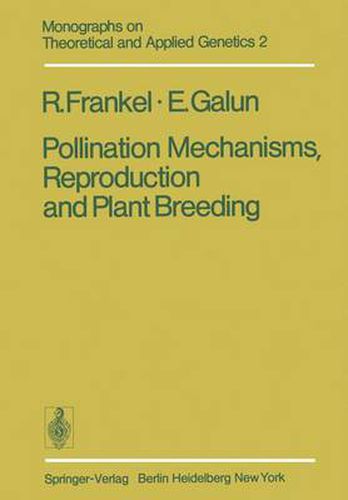Readings Newsletter
Become a Readings Member to make your shopping experience even easier.
Sign in or sign up for free!
You’re not far away from qualifying for FREE standard shipping within Australia
You’ve qualified for FREE standard shipping within Australia
The cart is loading…






This title is printed to order. This book may have been self-published. If so, we cannot guarantee the quality of the content. In the main most books will have gone through the editing process however some may not. We therefore suggest that you be aware of this before ordering this book. If in doubt check either the author or publisher’s details as we are unable to accept any returns unless they are faulty. Please contact us if you have any questions.
view than its own proper males should fecundate each blossom. ANDREW KNIGHT Philosophical Transactions, 1799 Pollination mechanisms and reproduction have a decisive bearing upon rational procedures in plant breeding and crop production. This book intends to furnish’ under one cover an integrated botanical, genetical and breeding-methodologi cal treatment of the reproductive biology of spermatophytes mainly angiosperms; it is based on an advanced topical course in plant breeding taught at the Hebrew University of Jerusa lem. We have tried to present a coverage which is concise, but as comprehensive as possible, of the pollination mechanism and modes of reproduction of higher plants, and to illustrate topics, whenever practicable, by examples from cultivated plants. Nevertheless, some relevant publications may have escaped our attention or may not be mentioned because of various limitations. The book is organized into three parts. The first part starts with an evaluation of the significance of the different pollination mechanisms for plant breeding and crop produc tion, describes modes of reproduction in higher plants and discusses ecology and dynamics of pollination. The second part is devoted to crops propagated by self pollination and describes specific breeding procedures for such crops. The third part details sexual reproduction in higher plants and handles three mechanisms involved in the prevention of self pollination and their utilization in plant breeding: sex expres sion, incompatibility, and male sterility.
$9.00 standard shipping within Australia
FREE standard shipping within Australia for orders over $100.00
Express & International shipping calculated at checkout
This title is printed to order. This book may have been self-published. If so, we cannot guarantee the quality of the content. In the main most books will have gone through the editing process however some may not. We therefore suggest that you be aware of this before ordering this book. If in doubt check either the author or publisher’s details as we are unable to accept any returns unless they are faulty. Please contact us if you have any questions.
view than its own proper males should fecundate each blossom. ANDREW KNIGHT Philosophical Transactions, 1799 Pollination mechanisms and reproduction have a decisive bearing upon rational procedures in plant breeding and crop production. This book intends to furnish’ under one cover an integrated botanical, genetical and breeding-methodologi cal treatment of the reproductive biology of spermatophytes mainly angiosperms; it is based on an advanced topical course in plant breeding taught at the Hebrew University of Jerusa lem. We have tried to present a coverage which is concise, but as comprehensive as possible, of the pollination mechanism and modes of reproduction of higher plants, and to illustrate topics, whenever practicable, by examples from cultivated plants. Nevertheless, some relevant publications may have escaped our attention or may not be mentioned because of various limitations. The book is organized into three parts. The first part starts with an evaluation of the significance of the different pollination mechanisms for plant breeding and crop produc tion, describes modes of reproduction in higher plants and discusses ecology and dynamics of pollination. The second part is devoted to crops propagated by self pollination and describes specific breeding procedures for such crops. The third part details sexual reproduction in higher plants and handles three mechanisms involved in the prevention of self pollination and their utilization in plant breeding: sex expres sion, incompatibility, and male sterility.